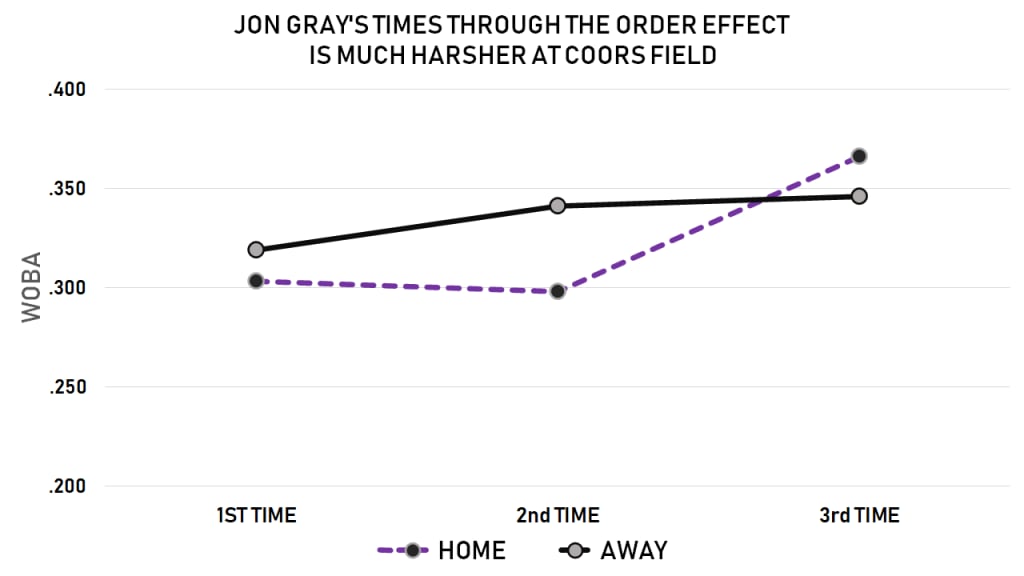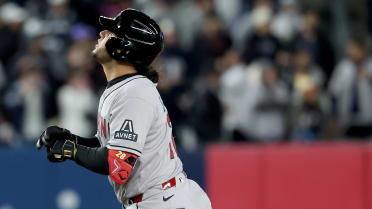After parts of seven seasons in Colorado and an inability to reach agreement on a contract extension, pitcher Jon Gray is a free agent, where he’ll probably be considered among the second tier of available starters -- though the fact that the Rockies shockingly declined to issue him a qualifying offer, meaning interested clubs will not have to surrender a Draft pick to sign him, will only help make his case more attractive.
As a pitcher who survived long enough at altitude to reach free agency (just the third in team history to do so, behind Jeff Francis and Aaron Cook), you might be tempted to look past his pedestrian 53-49, 4.59 ERA numbers, reasoning that escaping baseball’s foremost hitting paradise could only help him perform better. After all, it’s common (and deeply incorrect) to look at Rockies hitters and assume they’re only good because of their home park, so shouldn’t the opposite apply to pitchers?
It does, and it will, but not in the way you might think. Unlike when you have Nolan Arenado, D.J. LeMahieu or Trevor Story posting numbers far better at home than on the road, the opposite hasn’t actually been the case for Gray over his career. It hasn’t been close to true at all.
HOME (75 starts)
4.54 ERA, .326 wOBA, 3.91 FIP
AWAY (77 starts)
4.65 ERA, .329 wOBA, 3.91 FIP
Gray, somehow, has been almost identical at home and on the road, which pokes a hole in the idea that if he left, he’d suddenly be better. (Which is not dissimilar to the idea that if Rockies hitters leave, they’ll be unsuccessful, as Arenado, LeMahieu and others have proven false over the years.)
But if you dig deeper, there is something interesting here.
You’ve heard of the “third time through the order” effect by now, which shows that starting pitchers generally get less effective the more times they face a batter in a game, whether that’s due to fatigue, familiarity or likely both. Gray is not immune from this effect. Over his career, he’s allowed a .307 wOBA the first time through the lineup, a .320 wOBA the second time and a .356 wOBA the third time. (The 2021 MLB average for starting pitchers was .317.) He goes from good to fine to maybe-you-don’t-want-him-pitching. That’s not terribly surprising or unusual.
The difference is what happens when you look at this split by home and away, where he's been surprisingly better at Coors than on the road the first two times through the lineup, which points to why the Rockies should value his return so highly. Yet look what happens to him after that, on the third time through.
Gray, on the road, gets a little worse as he progresses through the game, just like most pitchers. Gray, at home, gets absolutely pounded the third time though.

That’s not necessarily true for other pitchers, at least not to the same extent. Since 2015, when Gray made his debut, he’s in the top 38% of starting pitchers in terms of performance at home the first two times through. He’s in the bottom 12% of starting pitching performance at home the third time through. He goes from being David Price or Joe Musgrove to being Derek Holland. It’s a huge difference.
So: What’s causing this?
The real effects of Coors
When you think about the various effects that playing a mile high has on baseball, a few things quickly come to mind.
You know that the ball flies further and home runs are plentiful, which is true, though not quite to the extent you’d expect. (Coors had the fourth-highest home run effect over the last three seasons.) You’d notice the enormous outfield -- there to prevent even more homers -- and note that outfielders simply cannot cover all that space, leading to plenty of non-homer hits, and that’s very true. (Coors has the highest ‘hits’ effect, by a considerable amount.)
But neither of those things change over the course of a game. Nor, either, does the other well-known effect of the thin air crushing movement on pitches, making curveballs curve less and fastballs rise less. These effects are all as true in the first inning as they are in the ninth. What does change as you go through?
It might be a little about a pitcher not having that third or fourth pitch to rely upon going deep in Coors, if their usual breaking ball isn’t breaking like it normally does. In Gray’s case, that doesn’t appear to be the concern, because he throws his pitches with very similar frequency the third time through at home as he does on the road.
But what if it’s also about the other large effect of life at altitude: What if it’s about the thin air exacerbating fatigue, thus making it more difficult to succeed going deeper?
“It’s a huge factor,” then-Pirates shortstop Clint Barmes said to the Denver Post in 2012, two seasons after ending an eight-year run with the Rockies when he was traded to the Astros. “Last year at Houston, getting away from the altitude, my body felt different for sure, not nearly as many aches. I felt much fresher, looser.”
“You get sore for doing less,” pitcher Francis said at the same time, nine years ago. “If you talk to guys from other teams who pitch here, they will feel much sorer than when they pitch somewhere else. … You go to L.A. and you go run and do your workout and you just feel great. When I’m running out there, I feel like I’m on a springboard. Then I come back here and it’s different, and you’re out of breath. Because of the coming and going over the course of the season, you just never get used to altitude.”
It’s still true, even more recently.
“There are times when players will say to me, ‘Man, I’m having trouble here. I’m sore. I’m having trouble breathing and trouble sleeping,’” Arenado relayed to The Athletic in 2019. “And I’m like, yeah, I deal with this every homestand.”
If this is true for Gray, it might be true for other pitchers, too. Going back to that list of starters since 2015 who struggled at home the third time through, well, six of the bottom 20 starters spent time calling Coors home. Plus, surely this can’t only affect the home team, anyway. Unsurprisingly, it doesn’t.
At every other park that isn’t Coors, starters have seen their wOBA jump by 3% from the first time to the second. Then, the ensuing jump to the third time through is only an additional 3% more. It's a somewhat steady decline, though likely obscured somewhat by the effects of averaging great pitchers and lesser ones together.
At Coors, the 29 non-Rockies teams have seen their starter’s wOBA jump by 5% from the first time through to the second, similar to other parks, with a small and not-surprising boost because Coors. The real shock comes after that, when there is a massive 14% additional jump from the second time to the third.
A decade ago, the Rockies were extensively maligned for attempting a short-lived experiment of using a four-man rotation with starters limited to 75 pitches per game. The grand mistake back then may have been with the sudden and awkward in-season implementation, as well as the relatively limited depth of the staff in the first place. It didn’t last long. You can see the merit, though, of wanting to avoid that third time through at home.
What might Gray look like without this concern?
But fatigue can manifest itself in different and difficult-to-quantify ways, like, say, command, and it’s not terribly hard to find that in how Gray’s fastball acts.
Or, for example, just see it in where his breaking balls and offspeed pitches land the third time through. At home, those pitches are more tightly clustered low in the zone, which isn't quite what's happening on the road.
Like, for example, on Sept. 25, when Gray held a very good Giants offense to one run through his first two trips through the lineup at home. In the fifth, facing Brandon Belt for a third time, his slider drifted right into Belt's power zone, turning a 2-1 Rockies lead into a 4-2 deficit they would not recover from.
None of this gets to the fact that in the first times through the lineup he's been more good than great no matter where he's pitched, and confoundingly better at Coors than on the road. But that simple matter of "being lit up the third time through at home" is responsible for nearly 20% of Gray's career earned runs.
There still remains a chance that Gray returns to Denver, of course, since he’s spoken positively about his experience there in the not-too-recent past. But now that Colorado’s exclusive period for speaking to him has passed, now that they’ve confoundingly declined to extend him the qualifying offer, the other 29 teams get a chance to talk to him too. They’ll be looking a lot deeper than just his home/road ERA splits. The Coors Effect goes ever-further than you thought.
Mike Petriello is a stats analyst for MLB.com, focusing on Statcast and Baseball Savant, and is also a contributor to MLB Network.




